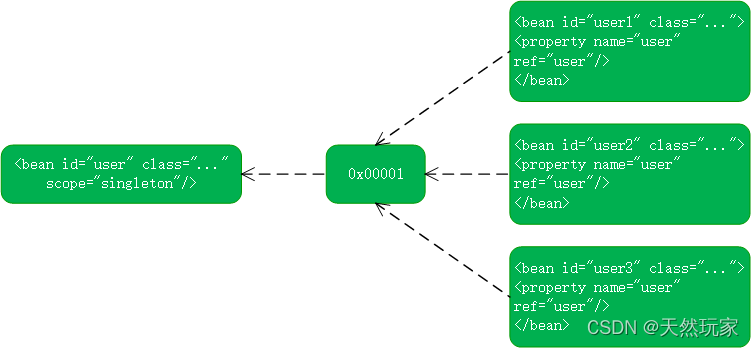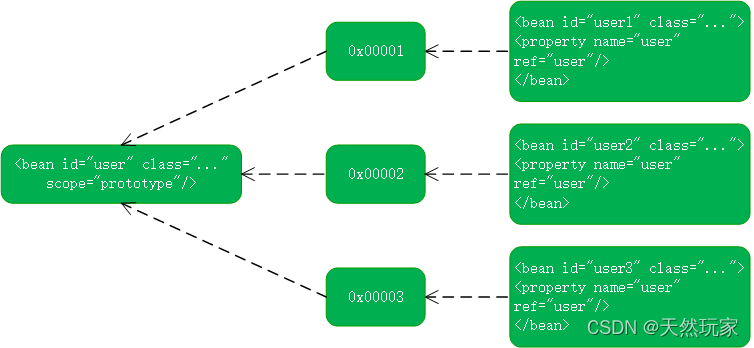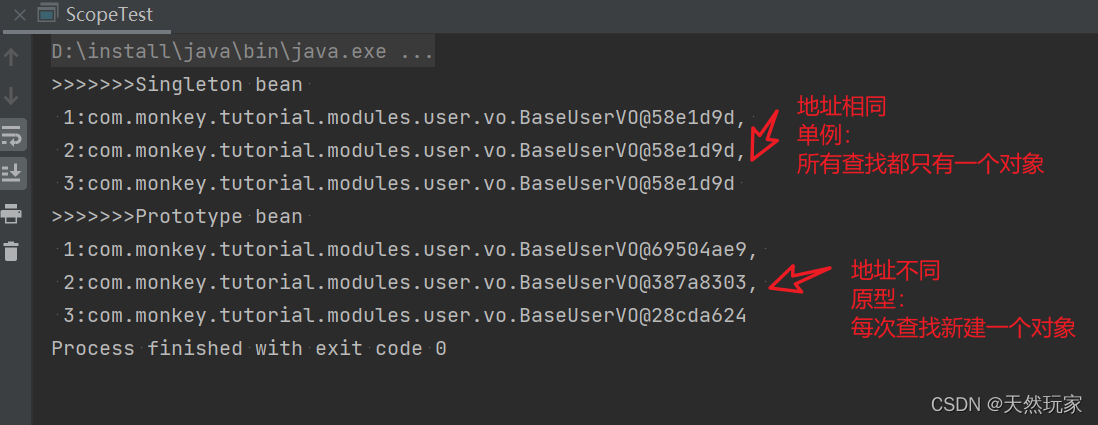1 作用域
简单理解:Bean作用域即对象创建的数量。
| 序号 | 作用域 | 描述 |
|---|---|---|
| 1 | singleton | 默认作用域。每次依赖注入或者查找都只有一份Bean对象 |
| 2 | prototype | 原型作用域。每次依赖注入或者查找都会新建Bean对象 |
| 3 | session | 每个Http Session都会新建一个Bean对象,Bean存在于HttpSession,适用于WebApplicationContext |
| 4 | request | 每个Http请求的都会新生成一个Bean对象,Bean存在于ServletRequest,适用于WebApplicationContext |
| 5 | websocket | 每个WebSocket生命周期新建一个Bean对象,适用于WebApplicationContext |
1.1 singleton
任何时刻,某个容器内都只有一个Bean对象。示意如图1.1所示。
1.2 prototype
每次依赖注入或者查找都会新建Bean对象。示意如图1.2所示。
2 测试
2.1 实体
去除方法:toString(),以便打印时输出对象地址,通过对象地址判断是否为同一个对象。
package com.monkey.tutorial.modules.user.vo;
import org.springframework.data.mongodb.core.mapping.Document;
import org.springframework.data.mongodb.core.mapping.Field;
import java.io.Serializable;
/**
* 用户基础信息.
*
* @author xindaqi
* @since 2021-06-05 08:42:41
*/
@Document(collection = "baseUserVO")
public class BaseUserVO implements Serializable {
private static final long serialVersionUID = 4774966681660887538L;
/**
* 用户主键id,MySQL自动生成
*/
@Field("id")
private long id;
/**
* 用户id
*/
@Field("userId")
private String userId;
/**
* 用户姓名
*/
@Field("username")
private String username;
/**
* 用户性别
*/
@Field("sex")
private String sex;
public BaseUserVO() {
}
public BaseUserVO(String userId, String username, String sex) {
this.userId = userId;
this.username = username;
this.sex = sex;
}
public void setId(long id) {
this.id = id;
}
public long getId() {
return id;
}
public void setUserId(String userId) {
this.userId = userId;
}
public String getUserId() {
return userId;
}
public void setUsername(String username) {
this.username = username;
}
public String getUsername() {
return username;
}
public void setSex(String sex) {
this.sex = sex;
}
public String getSex() {
return sex;
}
/**
* 自定义初始化Bean的初始化方法.
*/
public void init() {
System.out.println(">>>>>>>>>>BaseUserVO自定义初始化方法init(),START");
System.out.println(">>>>>>>>>>BaseUserVO自定义初始化方法init()执行");
System.out.println(">>>>>>>>>>BaseUserVO自定义初始化方法init(),END");
}
// @Override
// public String toString() {
// return "BaseUserInformation{" +
// "id=" + id +
// ", userId='" + userId + '\'' +
// ", username='" + username + '\'' +
// ", sex='" + sex + '\'' +
// '}';
// }
}
2.2 查找bean
使用@Scope新建两种Bean:Singleton和Prototype,
每次通过getBean查询Bean。
package com.monkey.tutorial.common.mybean;
import com.monkey.tutorial.modules.user.vo.BaseUserVO;
import org.slf4j.Logger;
import org.slf4j.LoggerFactory;
import org.springframework.beans.factory.config.ConfigurableBeanFactory;
import org.springframework.context.ApplicationContext;
import org.springframework.context.annotation.AnnotationConfigApplicationContext;
import org.springframework.context.annotation.Bean;
import org.springframework.context.annotation.Configuration;
import org.springframework.context.annotation.Scope;
/**
* Bean作用域(Scope)样例.
*
* @author xindaqi
* @date 2022-01-27 17:44
*/
public class ScopeTest {
@Bean(name = "singleton")
@Scope(ConfigurableBeanFactory.SCOPE_SINGLETON)
public BaseUserVO userSingleton() {
return new BaseUserVO("0x001", "singleton", "female");
}
@Bean(name = "prototype")
@Scope(ConfigurableBeanFactory.SCOPE_PROTOTYPE)
public BaseUserVO userPrototype() {
return new BaseUserVO("0x002", "prototype", "female");
}
public static void main(String[] args) {
ApplicationContext applicationContext = new AnnotationConfigApplicationContext(ScopeTest.class);
BaseUserVO baseUserVOSingleton1 = (BaseUserVO) applicationContext.getBean("singleton");
BaseUserVO baseUserVOSingleton2 = (BaseUserVO) applicationContext.getBean("singleton");
BaseUserVO baseUserVOSingleton3 = (BaseUserVO) applicationContext.getBean("singleton");
System.out.format(">>>>>>>Singleton bean %n 1:%s, %n 2:%s, %n 3:%s %n", baseUserVOSingleton1, baseUserVOSingleton2, baseUserVOSingleton3);
BaseUserVO baseUserVOPrototype1 = (BaseUserVO) applicationContext.getBean("prototype");
BaseUserVO baseUserVOPrototype2 = (BaseUserVO) applicationContext.getBean("prototype");
BaseUserVO baseUserVOPrototype3 = (BaseUserVO) applicationContext.getBean("prototype");
System.out.format(">>>>>>>Prototype bean %n 1:%s, %n 2:%s, %n 3:%s", baseUserVOPrototype1, baseUserVOPrototype2, baseUserVOPrototype3);
}
}
2.3 结果
运行结果如图2.1所示。
由图2.1可知,Singleton作用域每次查找Bean都只有一个对象;
Prototype作用域每次查询都会新建一个对象。
3 小结
- singleton |默认作用域。每次依赖注入或者查找都只有一份Bean对象
- prototype |原型作用域。每次依赖注入或者查找都会新建Bean对象
- session |每个Http Session都会新建一个Bean对象,Bean存在于HttpSession,适用于WebApplicationContext
- request |每个Http请求的都会新生成一个Bean对象,Bean存在于ServletRequest,适用于WebApplicationContext
- websocket |每个WebSocket生命周期新建一个Bean对象,适用于WebApplicationContext


